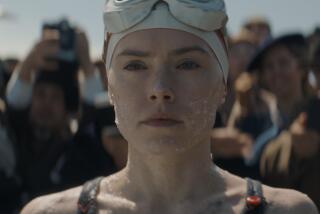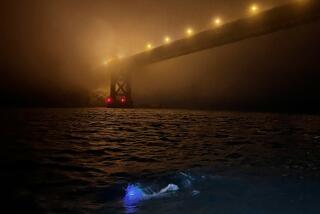Orange County Woman Swims Bering Strait
- Share via
BIG DIOMEDE ISLAND, Soviet Union — Exhausted, half-frozen but exhilarated, Lynne Cox stumbled ashore to a Russian picnic buffet here Friday after swimming the icy Bering Strait from Little Diomede Island in the U.S. to the Soviets’ Big Diomede in 2 hours, 5 minutes.
A temporary thaw fell upon the chilled waters with the historic swim of the cheerful, 30-year-old Los Alamitos woman, who brought the superpowers together in glasnost for a day.
“Obviously, this isn’t just about swimming,” she said afterward. “The swimming part was a challenge, but it was everything else that made it special.”
Vitaly Medjannikov, a Soviet swim coach who was in the reception party, said in English: “This is very much risk, very difficult. Lynne Cox is a hero, a women’s hero.”
Until Cox fulfilled an 11-year ambition to swim the 2.7-mile part of the strait where the International Dateline marks the only common border between the the U.S. and the Soviet Union, nobody had even attempted it.
The water freezes over in the winter, when interlopers have walked across and been sent back by the Soviets. Friday it was 44 degrees Fahrenheit, and Cox swam it without a wet suit or grease over her thin Speedo swimsuit.
Accompanied by an entourage of coaches, physicians, news reporters, Eskimo villagers and, for the last part of the journey, the Soviet Navy, Cox maintained a pace of 70 strokes per minute. At times fog limited visibility to 100 yards, but the northerly current was weaker than expected at about three-quarters of a knot. Because of the current, she could not swim directly across the strait and had to actually cover four to six miles.
It was only at the end, she said, that she tired and the current became a problem.
“It felt like I was in a big dishwasher,” she said. “I could feel it zig-zagging and I got caught in the folds of it.”
Along the way scientists accompanying her in walrus-skin boats, called umiaks, monitored her temperature with a thermosensitive capsule called a “radio pill” that was attached to her body and transmitted a signal to an instrument on the boat. Cox would roll over and backstroke for a minute while the doctors held an aerial over her stomach on the end of a long stick to take her temperature.
Dr. William Keatinge, an expert on hypothermia from the London Medical College, said Cox’s success “showed somebody with Lynne’s body composition and determination can get across in this water. Most people would get into trouble very quickly.”
Cox is 5 feet, 6 inches, and weighs 180 pounds. Keatinge estimated her body fat content at 35%, giving her important insulation from the cold.
“Her temperature had fallen a half-degree halfway across, but we weren’t able to get further readings until she had landed,” Keatinge said. “However, 10 minutes after she landed her temperature was 94--just on the margin of hypothermia.”
Started at 16
Cox launched a distinguished long-distance swimming career in 1972, when she set a record--for men or women--for an English Channel crossing of 9 hours, 57 minutes. She was 16 years old. Four years later, bored with repeating the usual long distance swims, she started plotting to swim the Bering and prepared with other cold-water swims, most of them shorter and not quite as cold, while earning a degree in English from the University of California, Santa Barbara.
It paid off Friday.
She had expected a stronger current to push her toward the north end of Big Diomede, and there was some fear that it might carry her beyond the island completely and into the Chukchi Sea. But she maintained a steady southwesterly course, occasionally corrected at the direction of Eskimos familiar with the waters.
The Soviets, who had not given permission for the swim until Thursday, sent a 30-foot navy launch to escort her from the International Dateline to the shore of this rocky island. The launch also discouraged the four small spectator boats from Little Diomede from proceeding beyond the unmarked boundary.
When the Soviet boat was spotted coming out of the fog, Cox’s project director, Joe Coplan, asked her: “Lynne, what day is this?”
“It’s tomorrow,” she yelled back happily, referring to the time change at the dateline, and sensing her goal was within reach. Finally, the high, steep cliffs of Big Diomede became visible.
The Soviets had set up a warming tent and two buffet tables, with a waiter in white smock serving hot tea, bread, dried fish and chocolate-covered coconut candy. And what appeared to be two uniformed army officers watched with binoculars and cameras from a hill directly above.
“They went all out for us,” Cox said. “Half a mile offshore I saw people lining the beach. It was wonderful.”
After Cox landed, Keatinge fussed impatiently as she received a bouquet of wildflowers and a pair of Eskimo slippers and was interviewed briefly for Soviet television. Then she was helped awkwardly over the boulders to the warming tent 75 yards away.
“In those 10 minutes walking along the beach, she probably just went into hypothermia,” Keatinge said.
But she remained coherent as hot packs were applied and she was wrapped in a warming bag that circulated hot air around her body. She remained in the tent for 90 minutes, lying on a cot while Keatinge and Dr. Rita Sacharova, a Soviet sports medicine specialist, attended to her.
Emerging later, Cox surveyed the scene and said: “I can’t believe that we are really here and that people are speaking Russian to us and it’s a sunny day in Siberia.”
Cox’s team returned to U.S. territory by boat.
More to Read
Sign up for Essential California
The most important California stories and recommendations in your inbox every morning.
You may occasionally receive promotional content from the Los Angeles Times.










